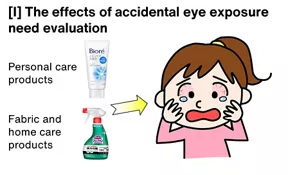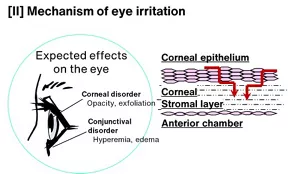Initiatives to Completely Replace Animal Experiments for the Eye Irritation Test
Life Science
The eye is an extremely important organ, since it is considered that 80% of the information humans receive comes from visual sense. The eye irritation test, which evaluates the effects of accidental contact with cosmetics as well as fabric and home care products to the eyes, is an indispensable part of the assessment to provide safe and secure products to customers.
Since 2000, Kao has been developing the “Short Time Exposure (STE)” test, an original in vitro eye irritation test using cultured corneal cells. The STE test has been peer-reviewed and is now listed as a Test Guideline (TG 491) by the Organisation for Economic Co-operation and Development (OECD). Although it is currently widely used in Japan and other countries, there are limitations to completely understanding complex biological responses with a single in vitro test.
Eye irritation starts when a substance comes into contact with the eye and quickly affects corneal epithelial cells. If the effect on the epithelial cells is severe, the substance can penetrate and damage corneal keratocytes. To focus on the biological responses that occur during eye irritation, Kao has developed a novel approach with a combination of the following two tests: the STE test and the Bovine Corneal Opacity and Permeability (BCOP) test (OECD TG 437). The former is highly accurate in assessing weak eye irritants, whereas the latter can assess severe eye irritants precisely.
To disseminate this approach worldwide, we have worked with Cosmetics Europe and were successful in getting the approach adopted as a test of OECD guidelines in 2022 (OECD TG 467). We believe that these efforts starting from the development of STE are important for providing an alternative approach for eye irritation and reduce animal experiments not only by Kao but also throughout the world.



- Home
- Innovation
- Research & Development
- Fundamental Research
- Safety Science
- Initiatives to Completely Replace Animal Experiments for the Eye Irritation Test
- Home
- Innovation
- Research & Development
- Fundamental Research
- Safety Science
- Initiatives to Completely Replace Animal Experiments for the Eye Irritation Test
